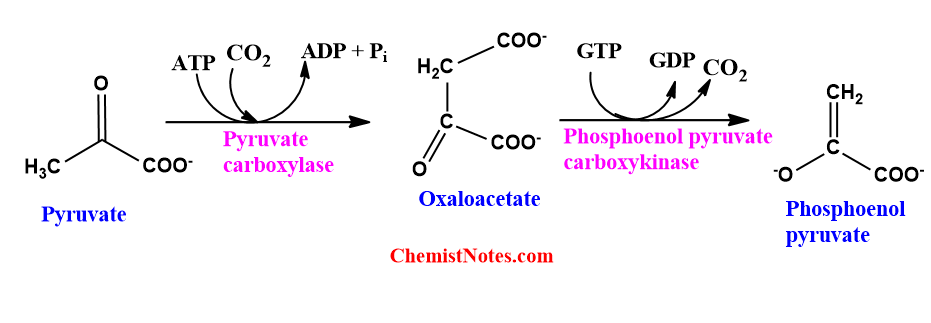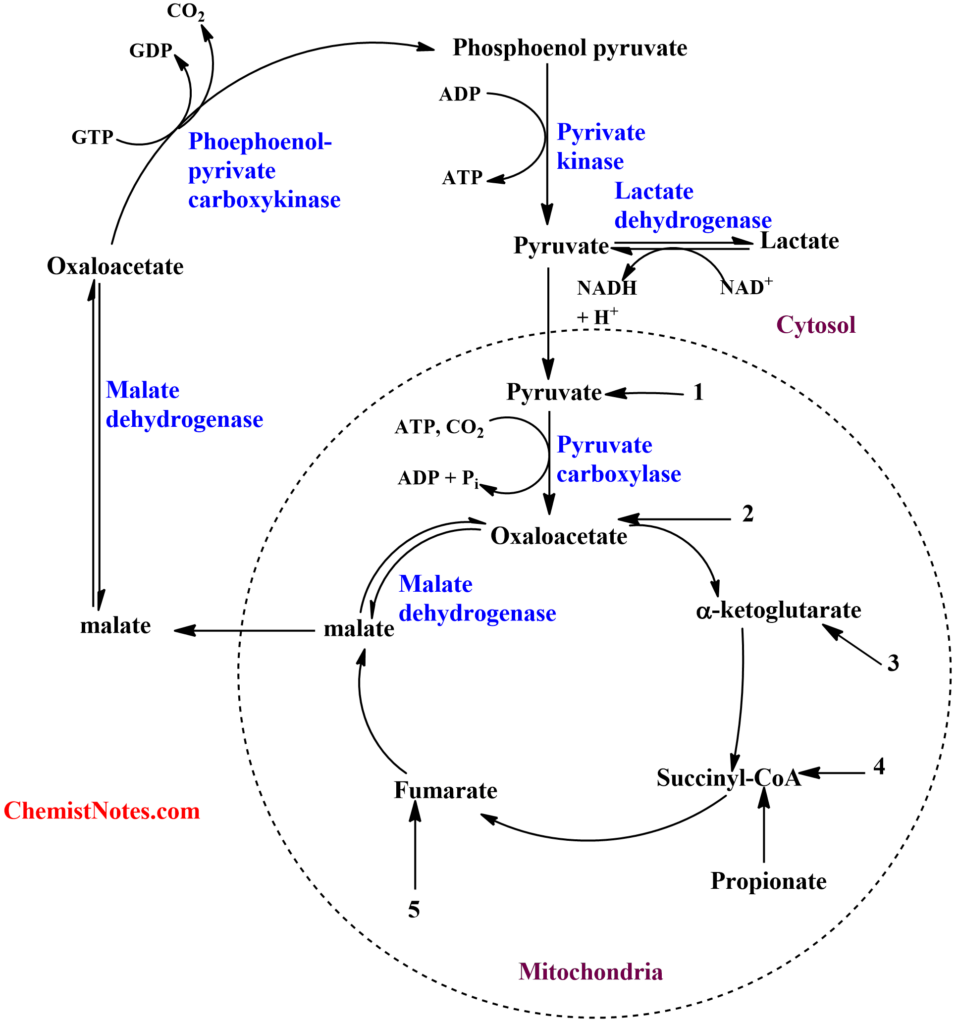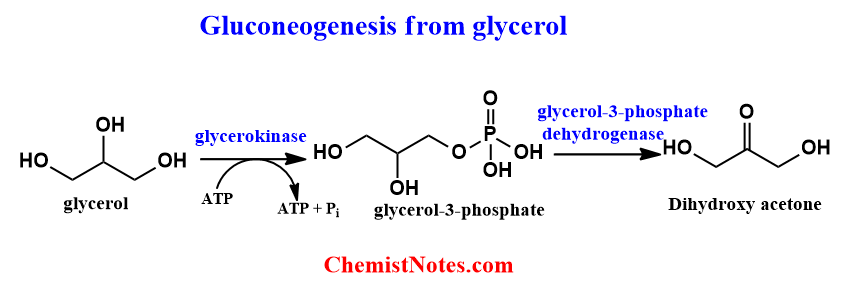Table of Contents
ToggleGluconeogenesis is a term that describes the synthesis of glucose from the non-carbohydrate precursor (pyruvate). It means In gluconeogenesis, the formation of glucose takes place from fats and proteins instead of carbohydrates.
Thus, the biosynthesis of glucose from non-precursor carbohydrates (sugar) is known as gluconeogenesis. The major precursors of gluconeogenesis include lactate, pyruvate, glucogenic amino acids, propionate, and glycerol. We have tried to explain the synthesis of glucose from these precursors briefly.
What is gluconeogenesis?
The formation of glucose from non-hexose precursors is called gluconeogenesis. The biosynthesis of glucose is an absolute necessity in all mammals, because the brain and nervous system, as well as the kidney medulla, testes, erythrocytes, and embryonic tissues, require glucose from the blood as their sole or major fuel source. The human brain alone requires over 120 g of glucose per day. Mammalian cells constantly synthesize glucose from simpler precursors such as pyruvate and lactate, then pass the glucose into the blood.
Gluconeogenesis is a universal pathway found in all animals, plants, fungi, and microorganisms. The reactions are the same in every case. The important precursors of glucose in animals are lactate, pyruvate, glycerol, and most of the amino acids.
Where does gluconeogenesis occur?
In higher animals, gluconeogenesis occurs largely in the liver (about 1 kg glucose per day) and to a much smaller extent in the kidney cortex (one-tenth of liver capacity). Gluconeogenesis occurs in the liver due to the action of Fructose-1,6-bisphosphatase.
In plant seedlings, stored fats and proteins are converted into disaccharides and sucrose for transport throughout the developing plant. Glucose and its derivatives are precursors in the synthesis of plant cell walls, nucleotides, co-enzymes, and a variety of other essential metabolites.
Many organisms are able to grow on simple organic compounds such as acetate, lactate, and propionate, Such organisms utilize simple organic molecules for the synthesis of glucose through gluconeogenesis.
As we know, the glycolytic conversion of glucose into pyruvate is a central pathway for the catabolism of carbohydrates, similarly, the conversion of pyruvate into glucose is a central pathway in gluconeogenesis. These pathways are not identical, although they share several steps.
When does gluconeogenesis occur?
Gluconeogenesis occurs during fasting (generally after around 8 hours of fasting). During prolonged fasting, glycogen level is depleted and gluconeogenesis starts to maintain the level of glucose.
Steps of gluconeogenesis
The reactions of the gluconeogenesis cycle are as follows.
1) Conversion of pyruvate to phosphoenol pyruvate
This reaction takes place in two steps, as shown in the figure below. In the first step, a biotin-dependent mitochondrial enzyme, pyruvate carboxylase, converts pyruvate to oxaloacetate in the presence of ATP and CO2. This enzyme regulates gluconeogenesis and requires acetyl-CoA for its activity.

Oxaloacetate is synthesized in the mitochondrial matrix, but gluconeogenesis occurs in the cytosol, so, it has to be transported to the cytosol. Being membrane-impermeable, oxaloacetate cannot diffuse out of the mitochondria, so it is converted to malate and then transported to the cytosol. In the cytosol, the oxaloacetate is regenerated by the enzyme malate dehydrogenase, an enzyme present in both mitochondria and the cytosol.
In the cytosol, phosphoenolpyruvate carboxykinase converts oxaloacetate to phosphoenolpyruvate. GTP or ITP is consumed in this reaction, and CO2 is liberated. For the conversion of pyruvate to phosphoenol pyruvate, two ATP equivalents are utilized.
2) Conversion of phosphoenol pyruvate to fructose-1,6-bisphosphate
Phosphoenol pyruvate then undergoes the reversal reactions of glycolysis until fructose-1,6-bisphosphate is produced.
3) Conversion of fructose-1,6-bisphosphate to fructose-6-phosphate
Fructose-1,6-bisphosphate is catalytically converted to fructose-6-phosphate by the enzyme fructose-1,6-bisphosphatase. This enzyme requires Mg2+ ions. Since fructose-1,6-bisphosphatase is absent in the smooth muscle and heart muscle, gluconeogenesis does not occur in the smooth muscle and heart muscle. This enzyme also regulates the gluconeogenesis reaction.
Then, fructose-6-phosphate is reversibly converted to glucose-6-phosphate by the enzyme glucose-6-phosphate isomerase.
4) Conversion of glucose-6-phosphate to glucose
Glucose-6-phosphatase catalyzes the conversion of glucose-6-phosphate to glucose. The presence or absence of this enzyme in a tissue determines whether the tissue is capable of contributing glucose to the blood or not. It is mostly present in the liver and kidney but absent in muscle, the brain, and adipose tissue.
The overall summary of gluconeogenesis is as follows:


Irreversible steps of gluconeogenesis
There are three irreversible steps in gluconeogenesis, which are also known as three bypasses of gluconeogenesis. The irreversible steps of gluconeogenesis are as follows:
- Conversion of pyruvate to phosphoenolpyruvate.
- Conversion of fructose-1,6-bisphosphate into fructose-6-phosphate.
- Conversion of glucose-6-phosphate into glucose.
Rate limiting step of gluconeogenesis
The conversion of fructose-1,6-bisphosphate to fructose-6-phosphate by the action of fructose-1,6-bisphosphatase is the rate-limiting step of gluconeogenesis. The enzyme fructose-1,6-bisphosphatase is absent in smooth muscles and heart muscles and present only in liver and kidney muscles, so, gluconeogenesis takes place only in the liver and kidney.
Substrates of gluconeogenesis
Glucogenic amino acids, lactate, glycerol, and propionate are the major substrates of gluconeogenesis. Let’s discuss how glucose is synthesized from these precursors.
Gluconeogenesis from amino acids
The carbon skeleton of glucogenic amino acids (all except leucine and lysine) results in the formation of pyruvate, or the intermediate of the citric acid cycle, which, ultimately results in the synthesis of glucose.
- Alanine, glycine, serine, cystine, threonine, and tryptophan are directly converted to pyruvate.
- Aspartate and asparagine are converted to oxaloacetate (intermediate of the citric acid cycle).
- Arginine, glutamate, glutamine, histidine, and proline are converted to α-ketoglutarate.
- Isoleucine, methionine, and valine are converted to succinyl-CoA.
- Phenylalanine and tyrosine are converted to fumarate.
Gluconeogenesis from propionate
Three-carbon propionyl-CoA is obtained by the oxidation of odd-chain fatty acids and also from the breakdown of some amino acids (methionine, isoleucine). Propionyl-CoA is converted to methyl malonyl-CoA by the action of propionyl-CoA carboxylase in the presence of ATP and biotin. Thus, obtained methyl malonyl-CoA is converted to succinyl-CoA in the presence of B12 coenzyme. Succinyl-CoA enters gluconeogenesis via the citric acid cycle.
Gluconeogenesis from lactate
Lactate, a major precursor of gluconeogenesis, is produced by active skeletal muscle. Pyruvate is reduced to lactate by the action of lactate dehydrogenase (LDH) under anaerobic conditions.

Lactate is a dead end in glycolysis since it must be reconverted to pyruvate for further metabolism. The main purpose of lactate production is to regenerate NADH so that glycolysis proceeds uninterrupted in skeletal muscle. Lactate or pyruvate produced in the muscle cannot be utilized for the synthesis of glucose due to the absence of the key enzymes of gluconeogenesis (glucose 6-phosphatase and fructose 1,6-bisphosphatase).

Gluconeogenesis from glycerol
Glycerol is liberated mostly in the adipose tissue by the hydrolysis of fats (triacylglycerols). Glycerol is converted to glycerol-3-phosphate by the action of the glycerokinase enzyme. The glycerol-3-phosphate is converted to dihydroxyacetone phosphate by the action of glycerol-3-phosphate dehydrogenase, an intermediate of the glycolysis cycle.

Regulations of gluconeogenesis
The gluconeogenesis reaction is mainly regulated by the glucagon hormone and the availability of substrate.
1) Influence of glucagon
Glucagon hormone is secreted by α-cells of the pancreatic islets. Glucagon stimulates gluconeogenesis by two mechanisms, which are as follows:
- i) Under the influence of glucagon, the activated form of pyruvate kinase is converted to an inactive form through the mediation of cyclic AMP. A decreased amount of pyruvate kinase results in reduced conversion of phosphoenolpyruvate to pyruvate and the phosphoenolpyruvate is diverted for the synthesis of glucose.
- ii) On the other hand, glucagon also reduces the concentration of fructose-2,6-bisphosphate. This compound allosterically inhibits phosphofructokinase and activates fructose-1,6-bisphosphate, both of these processes increase gluconeogenesis.
2) Influence of substrates
Among the various substrates, glucogenic amino acids have a stimulating influence on gluconeogenesis. Glucogenic amino acids are particularly important in a condition like diabetes mellitus (decreased insulin level), where amino acids are mobilized from muscle protein for the purpose of gluconeogenesis.
3) Acetyl-CoA promotes gluconeogenesis
During starvation, acetyl-CoA accumulates in the liver due to excessive lipolysis in adipose tissue, which allosterically activates pyruvate carboxylase, resulting in enhanced glucose production.
4) Alcohol inhibits gluconeogenesis
In the liver, ethanol is oxidized to acetaldehyde by the action of alcohol dehydrogenase. During this reaction, NAD+ is reduced to NADH.

As shown above, pyruvate and oxaloacetate, the predominant substrates of gluconeogenesis, are made unavailable by alcohol intoxication, and gluconeogenesis is inhibited. Alcohol consumption increases the risk of hypoglycemia (reduced plasma glucose) due to reduced gluconeogenesis.
Glycolysis vs Gluconeogenesis
However, three steps in glycolysis are essentially irreversible in vivo and cannot be used in gluconeogenesis: i) the conversion of glucose to glucose-6-phosphate by hexokinase ii) the phosphorylation of fructose-6-phosphate to fructose-1,6-bisphosphate, and iii) the conversion of phosphoenol pyruvate to pyruvate by pyruvatekinase.
These three steps are bypassed by a separate set of enzymes, catalyzing different reactions with different equilibria; they function in gluconeogenesis but not in glycolysis and are irreversible in the direction of glucose synthesis. Thus, both glycolysis and gluconeogenesis are reversible processes in cells.
Glycogenolysis vs gluconeogenesis
Glycogenolysis is the process of the breakdown of glycogen (polysaccharide of glucose) into glucose, whereas gluconeogenesis is the synthesis of glucose from non-carbohydrate precursors such as glucogenic amino acids, lactate, pyruvate, propionate, and glycerol. Glycogenolysis is a catabolic process; on the other hand, gluconeogenesis is an anabolic process.
Glycogenolysis generates a net total of 31–33 ATP molecules, depending on the type of electron shuttle system used by the cell, but gluconeogenesis requires a net of 12 ATP molecules for the production of one molecule of glucose by utilizing two pyruvate molecules.
FAQs/MCQs:
Is gluconeogenesis catabolic or anabolic?
Gluconeogenesis is an anabolic process because energy is required for the conversion of pyruvate into glucose.
What hormone stimulates gluconeogenesis?
Diabetogenic hormones such as glucagon, growth hormone, epinephrine, and cortisol stimulate gluconeogenesis.
Does gluconeogenesis increase blood glucose?
Yes, gluconeogenesis increases blood glucose levels.
An enzyme used in both glycolysis and gluconeogenesis is
3-phosphoglyceratekinase.
Gluconeogenesis and glycolysis are reciprocally regulated by
Change in energy level and the amount of glucose level in the cell.
What does suppress gluconeogenesis?
Insulin hormone suppresses gluconeogenesis
Where does gluconeogenesis occur in the cell?
Gluconeogenesis occurs in the mitochondria of the cell.
Where is the major site for gluconeogenesis?
The major site for gluconeogenesis but a small portion (1/10th) of the liver also occurs in the kidney.






